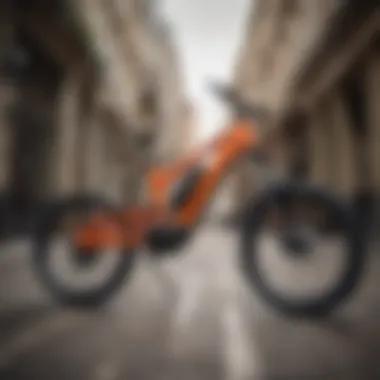An In-Depth Exploration of Haibike E-Bikes Performance


Intro
The world of cycling has seen a remarkable transformation with the rise of e-bikes, particularly from brands that have maintained a commitment to quality and innovation. Haibike stands out as a frontrunner in this ever-expanding market. Their e-bikes blend advanced technology with rugged design, catered towards both new riders and seasoned cyclists.
This discussion uncovers the various facets of Haibike e-bikes. It explores their engineering philosophy, a plethora of performance metrics, and practical applications. Additionally, the text examines how Haibike contributes to the cycling community and responds to current sustainability issues in the e-bike arena. By delving into these elements, readers will not only understand the technical specifications but also how to choose the right model that fits individual needs. Furthermore, the evolution of urban mobility spurred by e-bikes will be a focus area, tying together lifestyle shifts and transportation trends in cities around the world.
Design Philosophy
Haibike’s design philosophy prioritizes functionality, durability, and aesthetics. Each model is a testament to this ethos, exhibiting a blend of performance and style that appeals to a diverse customer base.
- Frame Construction: Haibike uses high-quality materials such as aluminum and carbon fiber for their frames. This ensures lightness without compromising strength.
- Integration of Technology: Many Haibike models incorporate the latest technology, including powerful batteries and smart displays. Features like integrated lights and sensors enhance usability.
This approach not only creates a visually appealing final product but also guarantees consistent performance, enhancing the riding experience for various terrains.
Technological Advancements
The technological innovation behind Haibike e-bikes is significant. With continuous investment in R&D, they have adapted to both market demands and advancements in electric mobility.
- Powerful Motors: Haibike utilizes mid-drive motors, specifically the Bosch Performance Line motors, which offers a perfect blend of power and efficiency. This helps in maintaining traction, even when tackling challenging trails.
- Battery Options: Different models come equipped with batteries ranging from 400 Wh to 625 Wh, catering to various ride needs. Riders can select models based on the distance they plan to travel.
The result is a set of e-bikes that significantly enhance cyclists' capabilities, allowing them to tackle longer distances and more challenging routes.
Performance Metrics
Examining the performance of Haibike e-bikes brings forth several metrics crucial for potential buyers.
- Speed: Most models allow users to reach up to 28 mph depending on assistance levels and terrain.
- Range: Depending on multiple factors including rider weight, terrain, and electric assist, ranges can vary extensively. Commonly, riders can expect anywhere from 30 to 90 miles.
- Weight Capacity: Haibike e-bikes typically support weights up to 300 lbs, taking into account rider and gear weight combined.
These performance attributes make Haibike e-bikes suitable for various cyclists, notably for adventurers, commuters, or those engaged in recreational riding.
Market Impact and Sustainability
The outdoor cycling community has been significantly influenced by the introduction of electric bikes, particularly those by Haibike. They aim to create a sustainable option that attracts a wide range of users, encouraging more people to engage in cycling as a primary mode of transport.
“E-bikes like those from Haibike not only change how we commute but promote a healthier lifestyle.”
Their focus on sustainability extends beyond product development. Haibike is committed to eco-friendly manufacturing practices, acknowledging its responsibility towards the environment.
End
In wrapping up, this exploration articulates the unique position of Haibike in the e-bike conversation. By skillfully combining advanced technology with user-friendly design, Haibike caters to a wide audience. The implications of e-bike adoption resonate profoundly on both personal and environmental levels. Understanding these dynamics allows potential buyers to make informed decisions about their cycling endeavors.
Intro to Haibike E-Bikes
Haibike e-bikes have garnered significant attention in the cycling and outdoor sports communities. Their growing popularity is not without reason; an array of distinctive features, combined with cutting-edge design, has solidified Haibike's stature in the market. Understanding what makes these bikes special is essential, especially given the current trends toward sustainability and efficient urban mobility.
This article seeks to delve into various aspects essential in understanding daily riders to find their ideal model.
Understanding E-Bikes
E-bikes revolutionize how we perceive cycling. Unlike traditional bicycles, Haibike incorporates electric motors that aid pedaling, offering enhanced speed and ease of operation on varied terrains. Enhanced performance allows individuals to travel medium to long distances without exerting excessive energy. This benefit is particularly valuable in hilly regions or for reaching appointments in time.
Moreover, the ride itself becomes more enjoyable. With the assistance of the electric motor, riders experience less fatigue, encouraging longer journeys and exploration. Haibike models cater to different preferences, providing both casual and more performance-oriented options.
E-bikes also present a solution to many urban commuters grappling with congestion. By seamlessly replacing car journeys with an e-bike ride, users can contribute to decreasing traffic and emissions. Additionally, the stable demand for e-bikes illustrates society's shift towards greener forms of transportation.
The Rise of Haibike in the Market
Haibike has elegantly positioned itself in the competitive e-bike landscape, characterized by continued growth and innovation. Founded in Germany, the brand benefits from a tradition of engineering excellence and rider-centric design. It is their unwavering commitment to quality and adaptability that has fostered rapid market acceptance.


The company's focus on rigorous testing and superior technology enables Haibike to deliver products that meet the rigorous demands of seasoned riders while ensuring that newcomers can embark on their cycling journey with confidence.
As e-bikes have transitioned from a niche product to a mainstream commodities, Haibike's entrance into the market coincided with global environmental awareness. Their strong emphasis on sustainability aligns with the broader movement towards eco-friendly transport options in urban environments. The brand’s evolving lineup intended to address specific use cases engrosses a diverse clientele niche, and sparks curiosity among extreme sports enthusiasts while also encouraging general cycling activities.
Design and Engineering
Design and engineering play a crucial role in the overall performance and functionality of Haibike e-bikes. Well-thought-out design ensures comfort and usability, while engineering determines how the components work in harmony with one another to create an optimal riding experience. Each element, from the frame to the motor, has its significance and helps elevate the development of advanced e-bike solutions.
Frame Construction
The frame is the backbone of any bicycle, including e-bikes. A well-designed frame contributes to strength, weight distribution, and overall stability. For Haibike, constructing a frame involves advanced materials such as aluminum or carbon fiber. Aluminum offers durability while keeping weight low, making it a popular choice for many models. Carbon fiber, though more expensive, provides remarkable stiffness and reduced excess weight.
The geometry of the frame also matters. For example, Haibike designs frames that focus on ride comfort, with specific angles and lengths that support various riding styles. Whether you're charging downhill or commuting across a flat road, the frame ensures stability and precision handling.
A robust frame significantly influences the lifetime of the bike. Industry-leading solutions enhance safety and performance that riders of various levels can appreciate.
Motor and Battery Integration
The way the motor and battery fit into the design influences an e-bike's performance, range, and user experience. Haibike emphasizes seamless integration; ensuring that the motor systems do not detract from the bike's aesthetics while ensuring optimal weight distribution. Most Haibike models employ mid-drive motors, generally positioned at the bike's center for better weight balance and handling.
The battery, usually placed in the frame's down tube or integrated into the rear triangle, is critical for effective performance. These batteries are designed with customer usability in mind—they are removable for easy charging yet also fit securely during rides. The combination of strategically chosen components has a direct influence on things like acceleration patterns, maximum torque, and overall efficiency.
Ergonomics and Aesthetics
User comfort comes first in Haibike's design priorities. Attention paid to ergonomics can enhance the quality of your riding experience significantly. Handlebar positions, seat designs, and pedal placements are all tailored to ensure a natural posture during long rides. Particularly for extreme athletes, a properly balanced bike allows for improved power transfer in pedaling and can effectively reduce fatigue.
Beyond comfort, aesthetics also play its own essential role. Stylishly integrated design elements can attract a wide range of riders. Haibike markets sleek lines alongside a modern finish without sacrificing quality or functionality. Color palettes are diverse, providing consumers with options to match their personality and preferences.
In summary, design and engineering serve already-established riders and newcomers blacklike alike to buy a bike ready for any adventure.
Feature Analysis
Feature analysis is key in understanding Haibike e-bikes. E-bikes combine technology with traditional cycling. This synergy enhances cycling experience. Knowing the features helps users make informed choices. Haibike focuses on precision and quality.
Types of E-Bikes Offered
Haibike provides a range of e-bikes tailored for various cycling activities. These include mountain biking, commuting, and leisure riding. Their electric mountain bikes are engineered for rough terrains. Models like the Haibike XDURO series showcase rugged grip and resilience. On the other hand, the SDURO models cater to fitness riders, balancing efficiency with comfort. These variations accommodate diverse user needs.
Key Types Include:
- XDURO Series: Best for serious mountain bikers, optimized for challenging trails.
- SDURO Series: Aimed at casual riders looking for a smooth commute or weekend rides.
- Urban Models: Focused on city commuting, integrating features for convenience and efficiency.
Key Specifications Explained
Understanding key specifications is crucial for evaluating any e-bike. For Haibike, various factors define what makes each bike unique.
- Motor Power: Typically ranges from 250W to 750W depending on the model and intended use. This range dictates the bike's ability to tackle climbs.
- Battery Capacity: Measured in Wh (Watt-hours), it affects overall range. Models often vary with capacities around 400Wh to 1000Wh.
- Weight: A lighter bike typically offers better maneuverability. Most Haibike e-bikes balance durability and weight well.
- Design Geometry: Enhanced geometry can influence handling and riding comfort, particularly on uneven surfaces.
Safety Features and Technology
Safety remains a top priority for riders. Haibike implements a series of advancements to enhance user security. Available technologies include:
- Integrated Lighting Systems: Position lights for better visibility while commuting at night.
- Braking Systems: High-quality hydraulic disc brakes ensure reliable stopping power in varied conditions.
- GPS Tracking: Some models come equipped for theft prevention, giving users peace of mind.
Performance Metrics
Performance metrics are crucial in understanding the capabilities of Haibike e-bikes. These metrics allow potential buyers to evaluate how well different models can meet their needs. Among the most importaant elements are speed and power, battery life and range, as well as handling and ride quality. An in-depth look at these elements can clarify the best choices based on user preferences and riding conditions.
Speed and Power Capabilities


Speed is a key factor that attracts many to Haibike e-bikes. Many models can reach high speeds, often between 20 to 28 miles per hour, thanks to robust motors. The powerful pedal assistance ensures climbs are easy, even on steep inclines. Power is delivered in watts – typically, overall capability of motors ranges from 250W to 750W in different models. Higher wattage translates to faster acceleration and performance under load.
The feel of riding these e-bikes gives confidence, especially for athletic users. Hill climbing and challenging terrains become manageable due to high power output. This enhances rider experience significantly. Moreover, it's important ľ to remind potential buyers that speed levels can vary depending on model specifications and battery performance too.
Battery Life and Range Analysis
Battery life is another aspect users consider when choosing an e-bike. Haibike models generally feature high-quality lithium-ion batteries. Most batteries offer a range from 30 to 80 miles on a full charge in normal riding conditions. Factors such as rider weight and terrain can affect range. Slight hills or aggressive riding may decrease overall distance achievable.
Charging times typically range from 4 to 6 hours when using standard outlets. Fast charging options are available, which can make charging easier for frequent riders.
Important Factors using E-bikes
- Weight of rider
- Terrain condition (flat vs hilly)
- Pedal assist mode selected
By acknowledging these typical behaviors, users gain insight into planning trips and lengthy journeys. Users aiming for long-distance rides will want to carefully assess their needs against the battery performance of specific models.
Handling and Ride Quality
Handling is vital for user experience. Haibike puts significant emphasis on ergonomics. The placement of the motor and battery creates a balanced weight distribution. This aids in stability and comfort, particularly in off-road conditions.
E-bikes from Haibike are designed with integrated suspension systems. This is highly beneficial for smooth rides over rugged terrain. Improved handlebar control means riders can maneuver better in various conditions. Long rides do not cause discomfort or fatigue, making these bikes suitable for longer distances.
Riding quality has infused technology that mitigates shocks and bumps while cycling. Brand reputation also hinges on such attributes, as users connect their experiences with overall performance. A competent ride, exhibiting good handling and ride comfort, fosters consumer trust.
It is essential to choose a bike that offers suitable handling and ride quality aligned with personal riding habits and preferences.
In summary, when evaluating a Haibike, focusing on performance metrics empowers buyers to land bikes that suit their cycling ambitions and routines.
User Experiences and Testimonials
User experiences and testimonials provide valuable insights into Haibike e-bikes. They help to contextualize the technical specifications within real-life usage scenarios, presenting a picture that statistics alone cannot convey. Understanding user feedback allows potential buyers to gauge performance, reliability, and satisfaction levels based on diverse perspectives.
Feedback from users varies widely, typically reflecting a spectrum of experiences. Beginner riders often express a sense of empowerment when they start cycling. They appreciate the adjustable levels of assistance and user-friendly designs. Advanced users tend to provide deeper insights, critiquing particular aspects based on extended usage, including battery efficiency and terrain handling. This formed literature serves as a guide, enabling informed decisions importantly rooted in practical experience.
Genuine user reviews often highlight the subtleties of specific Haibike models. Such insights can greatly aid in purchasing choices.
Beginner Insights
Beginner insights are crucial for newcomers who may be apprehensive about adopting an e-bike. Users often share their first experiences riding Haibike e-bikes, noting how intuitive the design feels. Feedback typically highlights easy assembly, prompting some new cyclists to not feel overwhelmed by technical specifications. Users express that starting with a Haibike allows them to engage more quickly in riding and exploring their surroundings.
Common likes among beginners include:
- Lightweight Construction: Numerous users appreciate lighter frames, making handling easier.
- User-Friendly Mode: Simple controls inclusive of different levels of pedal assistance reassure new riders up front, encouraging them to adapt.
- Comfortable Seat and Setup: Riders mention how comfortable their position feels, even on longer rides.
These aspects form a foundation for lasting engagement with cycling.
Advanced User Feedback
Advanced users provide nuanced feedback that focuses on comprehensive comparisons with rivals and critiques highlighting long-term use. Enthusiasts often underscore specific performance points such as acceleration and climbing capabilities on Haibike e-bikes.
Users share observations like:
- Smooth Gear Transitioning: Elevated cyclist mastery is mirrored in advanced riders’ applause for the range of gear ratios and smooth transitions.
- Terrain Versatility: Various users tout the Haibike’s adaptability to off-road paths, making them appealing for adventure seekers.
- Durable Batteries: Many note how sustained performance still appears impressive over prolonged use across varied conditions.
This segment of testimonies elaborates the durability, efficiency, and versatility aspects that become clear after long-term investments.
Comparative Analysis with Other Brands
When users compare Haibike e-bikes against other brands, specific elements consistently surface in discussions. Conversations on forums like reddit.com often yield comparisons highlighting technical specifications, ride comfort, and price positioning. The overall sentiment frequently switches in favor of Haibike, but it is not without critique.


Key points of feedback malware in these discussions include:
- Superior Battery Life: Many riders assert the lasting draw of Haibike's battery technology stands out versus rivals.
- Price versus Performance: Enthusiasts often mention encountering models of other brands that price high but do not deliver simular performance or build quality.
- Innovative Tech Integration: Users have expressed enthusiasim for Haibike's embracing newer tech, such as touch-screen displays and smart connectivity.
In summary, the narrative drawn from comparative reviews helps guide new buyers in navigating through the wide e-bike market.
Maintenance and Care
Maintaining Haibike e-bikes is essential for ensuring optimal performance and longevity. Regular care not only enhances the riding experience but also prevents costly repairs down the line. Lack of maintenance can lead to various issues that degrade the bike's abilities over time. In this section, we will explore routine tasks, methods for troubleshooting issues, and potential upgrades that could elevate an e-bike from effective to exceptional.
Routine Maintenance Tasks
Regular maintenance tasks play a significant role in keeping your Haibike running smoothly. First, it is important to check the battery condition regularly. This includes monitoring its charge and ensuring that connections are clean and secure. Moreover, tire pressure should be checked before each ride. Properly inflated tires contribute greatly to ride quality and can affect overall range as well.
Another crucial aspect is to keep the chain lubricated. A well-lubricated chain can improve shifting, reduce wear, and enhance performance. Dust and dirt can accumulate on just about any part of a bike which leads to friction and consequently, breakdowns. It is recommended to clean your bike after every few rides, especially after having ridden in muddy or wet conditions.
- Inspect brake pads for wear and replace them if needed.
- Examine cables for fraying and ensure they operate smoothly.
Troubleshooting Common Issues
Even with proper maintenance, issues may arise from time to time. Some common problems with e-bikes include electrical failures and mechanical difficulties. When faced with non-responsive controls, it is wise to start by checking if the battery is charged. If the battery seems fine, inspect the connectors and fuses for any signs of damage.
Other prevalent issues can include poor braking performance and strange noises. If brakes don't respond efficiently, check the adjustment of both brake levers and pads. Addressing these concerns helps to ensure a safe riding experience.
- If you notice inconsistent power delivery, test the motor for faults or wiring issues.
- A squeaky sound may indicate that lubrication is needed or components may need adjusting.
Upgrades and Modifications
Upgrading your Haibike can significantly improve performance and efficiency. First, consider a custom seat that provides better comfort for longer rides. Additionally, you may choose to enhance the bike’s lights to improve visibility during evening rides. Another possible upgrade is the installation of fenders; this helps protect from mud and spray, enhancing ride cleanliness.
Adding digital displays can improve the overall functionality and provide data at a glance, relevant for kitesurfers and extreme athletes.
The Future of E-Bikes
The future of e-bikes is a vital aspect of this article, emphasizing the ongoing evolution of cycling through technological advancements and market dynamics. The emergence of e-bikes has brought significant benefits to urban mobility, allowing for more efficient transportation alternatives. This section highlights the trends that shape the industry and the considerations necessary for an environmentally sustainable future.
Market Trends and Innovations
E-bikes are becoming a pivotal part of the cycling landscape. There are wide-ranging trends driving their growth. First, the influence of urbanization cannot be overstated. As cities become more crowded, the demand for efficient, compact transportation solutions rises.
Next, the integration with technology, such as GPS and anti-theft systems, is enhancing user experience. Usage of smartphones with e-bike connectivity increases convenience further. Innovative battery technology is another aspect to consider. Companies are constantly working on increasing capacity while reducing the weight of batteries, ultimately making rides more enjoyable and naarable.
Among significant innovations, the development of lighter materials for frame construction deserves mention. Carbon fiber and advanced alloys provide strength and mobility without sacrificing durability. This progression into lightweight builds not only affects performance but also appeals to performance enthusiasts.
“E-bikes are at the intersection of sustainability and newer technology, making them a driver of change in urban transport.”
Sustainability and Environmental Considerations
The sustainability aspect is crucial when discussing the future of e-bikes. Transportation accounts for a large fraction of global emissions. Shifting toward e-bikes offers a tangible solution to reduce dependence on cars and thereby minimize the carbon footprint. Particularly in urban areas, incorporating e-bikes into daily transport can decrease congestion, which contributes to lower emissions.
Haibike and other leading manufacturers are increasingly committing to sustainable practices. This includes the ethical sourcing of materials and superior building processes that minimize environmental impact. Besides, their efforts go beyond just creating e-bikes. They often enforce sustainability initiatives, such as recycling campaigns for old batteries.
With growing public consciousness revolving around climate change, consumer preferences are shifting in favor of eco-friendly products. Manufacturers must recognize this shift and elaborate on how their products integrate into these broader sustainability goals. Involvement in local cycling initiatives further supports community engagement around eco-conscious transport options.
Aligned with these considerations, ongoing research into end-of-life solutions for e-bike components plays a necessary role. Finding ways to recycle or repurpose electronic parts will reinforce the commitment to sustainability.
Culmination
The conclusion provides a summative vision into the primary discussions detailed throughout this article. It emphasizes the multifaceted nature of Haibike e-bikes and the significant potential for growth within the electric bike market. Understanding these elements is crucial, not just for current cyclists, but also for those considering e-biking as a viable mobility solution.
Recap of Key Points
Throughout the article, several essential aspects of Haibike e-bikes were examined. These include:
- Design Philosophy: Haibike emphasizes functional design paired with innovation, creating models catering to various cycling needs.
- Technological Advances: The integration of reliable motors and sophisticated battery systems enhances performance and user experience.
- User Experiences: Feedback from various skill levels explains the adaptability of Haibike models in diverse environments, appealing to both beginners and advanced cyclists alike.
- Maintenance: Regular care and possible upgrades suggest longevity and performance consistency in e-bikes.
- Market Insights: The evolving dynamics of e-bike markets paired with sustainability practices reflect Haibike’s proactive approach to environmental challenges.







